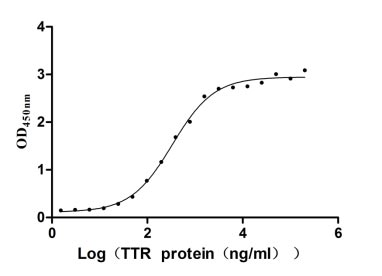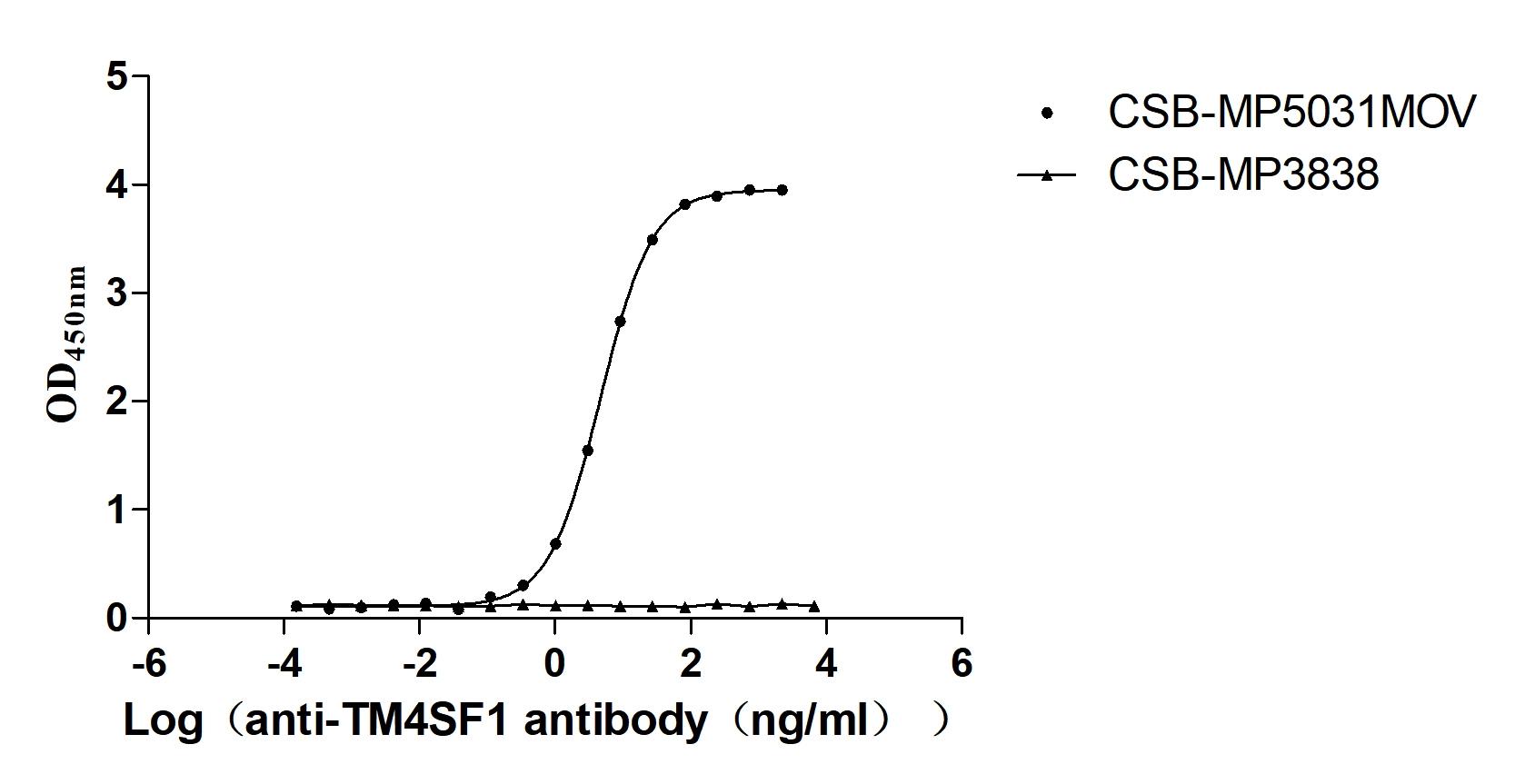Recombinant Mouse Neural cell adhesion molecule 1 (Ncam1), partial
-
货号:CSB-YP015511MO
-
规格:
-
来源:Yeast
-
其他:
-
货号:CSB-EP015511MO-B
-
规格:
-
来源:E.coli
-
共轭:Avi-tag Biotinylated
E. coli biotin ligase (BirA) is highly specific in covalently attaching biotin to the 15 amino acid AviTag peptide. This recombinant protein was biotinylated in vivo by AviTag-BirA technology, which method is BriA catalyzes amide linkage between the biotin and the specific lysine of the AviTag.
-
其他:
-
货号:CSB-BP015511MO
-
规格:
-
来源:Baculovirus
-
其他:
-
货号:CSB-MP015511MO
-
规格:
-
来源:Mammalian cell
-
其他:
产品详情
-
纯度:>85% (SDS-PAGE)
-
基因名:
-
Uniprot No.:
-
别名:Ncam1; Ncam; Neural cell adhesion molecule 1; N-CAM-1; NCAM-1; CD antigen CD56
-
种属:Mus musculus (Mouse)
-
蛋白长度:Partial
-
蛋白标签:Tag type will be determined during the manufacturing process.
The tag type will be determined during production process. If you have specified tag type, please tell us and we will develop the specified tag preferentially. -
产品提供形式:Lyophilized powder
Note: We will preferentially ship the format that we have in stock, however, if you have any special requirement for the format, please remark your requirement when placing the order, we will prepare according to your demand. -
复溶:We recommend that this vial be briefly centrifuged prior to opening to bring the contents to the bottom. Please reconstitute protein in deionized sterile water to a concentration of 0.1-1.0 mg/mL.We recommend to add 5-50% of glycerol (final concentration) and aliquot for long-term storage at -20℃/-80℃. Our default final concentration of glycerol is 50%. Customers could use it as reference.
-
储存条件:Store at -20°C/-80°C upon receipt, aliquoting is necessary for mutiple use. Avoid repeated freeze-thaw cycles.
-
保质期:The shelf life is related to many factors, storage state, buffer ingredients, storage temperature and the stability of the protein itself.
Generally, the shelf life of liquid form is 6 months at -20°C/-80°C. The shelf life of lyophilized form is 12 months at -20°C/-80°C. -
货期:Delivery time may differ from different purchasing way or location, please kindly consult your local distributors for specific delivery time.Note: All of our proteins are default shipped with normal blue ice packs, if you request to ship with dry ice, please communicate with us in advance and extra fees will be charged.
-
注意事项:Repeated freezing and thawing is not recommended. Store working aliquots at 4°C for up to one week.
-
Datasheet :Please contact us to get it.
相关产品
靶点详情
-
功能:This protein is a cell adhesion molecule involved in neuron-neuron adhesion, neurite fasciculation, outgrowth of neurites, etc.
-
基因功能参考文献:
- PrP and ZIP6 inherited the ability to interact with NCAM1 from their common ZIP ancestors but have since diverged to control distinct posttranslational modifications of NCAM1. PMID: 28098160
- inhibiting NCAM1 would be cardioprotective, counteract the pathological action of TGFbeta1 and reduce heart failure severity. PMID: 28870505
- NCAM deletion in young adult mice reduces recovery after spinal cord injury. PMID: 27178448
- the neural cell adhesion molecule NCAM is co-expressed and directly interacts with GFRalpha1 in embryonic Purkinje cells. PMID: 28076782
- Increased polysialylation of the NCAM has been found in a transgenic mouse model of sialuria. PMID: 27966821
- study delineates a mechanism in which NCAM promotes ephrin-A5-dependent clustering of EphA3 through interaction of the NCAM Ig2 domain and the EphA3 CRD, stimulating EphA3 autophosphorylation and RhoA signaling necessary for growth cone repulsion in GABAergic interneurons in vitro, which may extend to remodeling of axonal terminals of interneurons in vivo. PMID: 27803162
- data provided molecular details about the interaction between HuPrP and the NCAM fibronectin domain, and revealed a new role of PrP(C) N terminus as a dynamic and functional element responsible for protein-protein interaction. PMID: 27535221
- Results demonstrate that the early development of calbindin-positive periglomerular interneurons depends on the presentation of polysialic acid on NCAM and requires the activity of both St8sia2 and St8sia4 PMID: 26153130
- NCAM plays significant roles in the adult visual system in establishing normal retinal anatomy, physiology and function, and in maintaining vision during aging. PMID: 27103522
- The data of this study demonstrated the importance of NCAM for the development and functional activity of the BDNF signaling and serotonergic neurotransmission PMID: 26499173
- PrP-deficient cells fail to undergo NCAM1 polysialylation during EMT. PMID: 26288071
- NCAM-140 significantly promoted cell proliferation, motility and migration, while polysialylation of NCAM-140 catalyzed by STX, but not by PST, enhanced NCAM-mediated cell migration, but not cell proliferation or motility. PMID: 25885924
- changes of NCAM expression in the late postnatal and mature forebrain determine avoidance behaviour and serotonin (5-HT)1A receptor signalling. PMID: 24751161
- Dicer ablation in the early metanephric mesenchyme results in severe renal dysgenesis despite normal initial specification of nephron progenitors and ureteric bud outgrowth. PMID: 24500693
- The molecular clock governs rhythmic ncam1 alpha1-2-fucosylation in secondary olfactory neurons. PMID: 25384980
- PrP plays a critical role in neuronal differentiation of neuralprecursor cells and suggest that this function is, at least in part, NCAM-dependent. PMID: 24497115
- This study propose that presynaptic NCAM bridges a critical link between the SV cycle and the functional expansion of synaptic territory through the regulation of L-VDCCs. PMID: 25100585
- findings suggest that NCAM-mediated processes are involved in both novelty/stress-related emotional behavior and in cognitive function during spatial learning PMID: 24000815
- findings support involvement of NCAM in regulation of emotional and aggressive behaviors, suggesting that diminished NCAM expression might be a critical vulnerability factor for development of these behavioral alterations under repeated exposure to stress PMID: 24010949
- The presynaptic endocytotic machinery remains immature in adult NCAM-deficient (NCAM-/-) mice accumulating AP-3 instead of AP-2 and its partner protein AP180 in synaptic membranes and vesicles. PMID: 24133283
- Intragenic epigenetic changes modulate NCAM alternative splicing in neuronal differentiation. PMID: 23892457
- The data of this study indicated that reduced NCAM expression in the forebrain might be a critical factor for the occurrence of cognitive impairments during aging. PMID: 23504516
- These results reveal a new mechanism in which NCAM and ephrinAs/EphA3 coordinate to constrain GABAergic interneuronal arborization and perisomatic innervation. PMID: 22275477
- In contrast to NCAM-deficient mice, NCAM+/- heterozygotic animals do not demonstrate memory impairment in either object recognition or contextual fear conditioning tests. PMID: 22361116
- Results indicate that the polySTs ST8SiaII and ST8SiaIV not only recognize an acidic patch in the FN1 domain of NCAM but also must contact sequences in the Ig5 domain for polysialylation of Ig5 N-glycans to occur. PMID: 23341449
- Our combined observations thus indicate that NCAM activates Pak-1 to drive actin polymerization to promote neuronal differentiation PMID: 23303955
- alterations in PSA-NCAM levels were seen in the cerebral cortex immediately after injury, and these reductions persisted in brain regions distal to the primary injury site PMID: 22848850
- The findings indicate that diminished NCAM expression might be a critical vulnerability factor for the development of behavioral alterations by stress and further support a functional involvement of NCAM in stress-induced cognitive and emotional disturbances. PMID: 21939373
- NCAM deficiency impairs mesenchymal stromal cell motility. PMID: 22683856
- NCAM180 regulates Ric8A membrane localization and potentiates beta-adrenergic response PMID: 22384181
- An abnormally high rate of postsynaptic membrane endocytosis may thus contribute to brain pathologies associated with mutations in NCAM or spectrin. PMID: 21339376
- data suggest that affecting homeostasis of NCAM polysialylation may lead to alterations in precise neuronal circuit formation PMID: 22068610
- In twelve-month-old NCAM-deficient (but not NCAM-positive) mice, hippocampal long-term potentiation is impaired by comparison with 3-month-old mice that could be rescued by d-cycloserine, a GluN2A agonist. PMID: 22396402
- N-CAM exhibits a regulatory function in pathological angiogenesis in oxygen induced retinopathy. PMID: 22043302
- The polysialylated form of Ncam appears to provide a mechanism for modulation of chronic sensory overload, by means of attenuation of the activity of the NCAM-180 isoform, which reduces nociceptive transmission. PMID: 22200540
- Plannexin facilitates neurite outgrowth in primary hippocampal neuronal cultures and improves spatial learning under conditions involving a deficit in a key plasticity-promoting posttranslational modification of NCAM, its polysialylation. PMID: 21887252
- these findings show a co-localization of NCAM and FGFR2 in early vertebrate development with intracellular signaling pathways present to enable a cellular response PMID: 21710437
- results suggest a novel role of NCAM in promoting insulin signaling and adipocyte differentiation of adult stem cells. PMID: 21730021
- Immobilized pool of NCAM180 in the postsynaptic membrane is homeostatically replenished by the flux of NCAM180 from extrasynaptic regions. PMID: 21550975
- NCAM potentiates cellular invasion and metastasis of melanoma cells through stimulation of PKA and PI3K signaling pathways PMID: 21277992
- we reveal a novel role for NCAM in that it regulates addition of the new membrane to the cell surface of growth cones in developing neurons. PMID: 21389209
- (polysialic acid)In embryonic stem cells overexpressing polysialic acid there is an enhanced chemotatic migration towards gradients of chemoattractants. PMID: 17823239
- NCAM-dependent rearrangements of the membrane associated spectrin meshwork via caspase-8 dependent caspase-3 activation are thus indispensable for NCAM-mediated neurite outgrowth PMID: 20961848
- analysis of cytolytic CD56(dim)CD16+ NK cells as rapid producers of abundant IFN-gamma on activation PMID: 21187373
- NCAM in the amygdala mediates consolidation of auditory fear conditioning; increased NCAM expression in the amygdala is among the mechanisms whereby stress facilitates fear conditioning processes. PMID: 20059553
- NCAM mediates cell recognition processing of amygdalo-hippocampal system modulation of contextual fear memory. PMID: 20003620
- The alteration of neuronal remodeling proteins in the hippocampus may be an underlying mechanism of venlafaxine in treating post-stroke depression. PMID: 20651837
- NCAM-mediated pathways may be involved in the activation of extracellular signal-regulated MAP kinases at acute stages and upregulation of GAP-43 expression to promote cell survival, regenerated axons, synaptogenesis, and function recovery. PMID: 20381564
- A novel interaction was identified between NCAM and spike protein and this association is critical during porcine hemagglutinating encephalomyelitis virus infection. PMID: 20863409
- NCAM is a cardioprotective factor up-regulated under metabolic stress in cardiomyocytes PMID: 19853610
显示更多
收起更多
-
亚细胞定位:[Isoform 1]: Cell membrane; Single-pass type I membrane protein.; [Isoform 2]: Cell membrane; Single-pass type I membrane protein.; [Isoform 3]: Cell membrane; Lipid-anchor, GPI-anchor.
-
数据库链接:
KEGG: mmu:17967
STRING: 10090.ENSMUSP00000130668
UniGene: Mm.439182
Most popular with customers
-
Recombinant Human Transthyretin (TTR) (Active)
Express system: Mammalian cell
Species: Homo sapiens (Human)
-
Recombinant Macaca mulatta Semaphorin-4D isoform 1 (SEMA4D), partial (Active)
Express system: Mammalian cell
Species: Macaca mulatta (Rhesus macaque)
-
Recombinant Human Claudin-6 (CLDN6)-VLPs, Fluorescent (Active)
Express system: Mammalian cell
Species: Homo sapiens (Human)
-
Recombinant Macaca fascicularis Transmembrane 4 L6 family member 1 (TM4SF1)-VLPs (Active)
Express system: Mammalian cell
Species: Macaca fascicularis (Crab-eating macaque) (Cynomolgus monkey)




f4-AC1.jpg)











